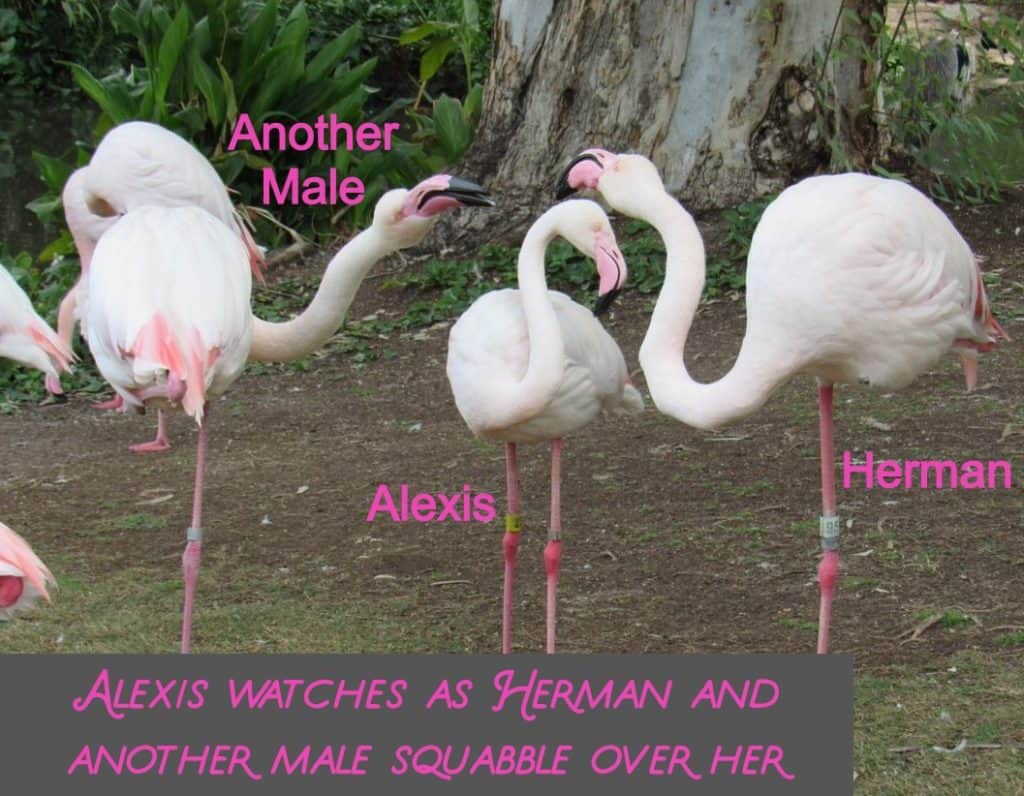By Carrie Flood, Community Learning Manager
Welcome to Flamingo Cove
Mudslinging. Snap judgements. Jealous rivalries. Clandestine romances. Shouting matches. Face-to-face showdowns.
And that’s just the adults; the kids are worse.
This isn’t politics; I’m talking about flamingos.
Turns out Game of Thrones could have been based on a slow day in Flamingo Cove…
Episode 10: A New Hope
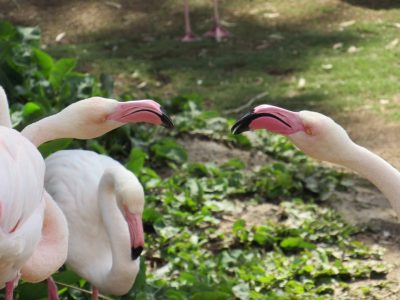
Welcome to Flamingo Cove, where the only thing heating up faster than the temperature is the competition!
We’re back after a long hiatus, but luckily, we can pick up right where we left off because flamingo drama is nothing if not constant. While many things are the same, there have been some changes and even a surprise or two, so get comfy and let’s get caught up with the pink birds!
Recently, in response to cues from the birds, keepers added some fresh clay and water to make a nice muddy patch. This sent the birds into a frenzy of nesting related behaviors. This won’t necessarily result in any actual nesting, but like everything to do with the flamingos, it’s one step in a ridiculously long and complex process. Most of the flock came over to investigate, standing in the mud, testing with their beaks, but mostly standing still with their heads down and staring at the ground. There was lots of squabbling breaking out about who gets to stand in which mud, but that’s pretty typical. (If you’re new to Hot Pink, flamingo lifestyle is one long squabble with short breaks for eating and dancing.)
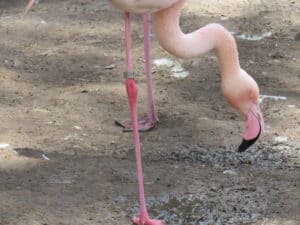
(Intently starting at the mud)
One interesting thing that happened was one of the newly minted teenage couples, Kiernan (black band #10) and Tom (black band #6) laid claim to a small mound. Tom stood on the mound and began furiously collecting debris while Kiernan cheered him on. (Mostly by standing nearby and staring.) Just when it looked like they kind of had the hang of it, an unpaired adult bird came over, pushed Tom off the mound and sat down right on top of it.
Well, OK then. Seems as though that’s that.
We won’t know for a while if the birds will actually nest this year. Flamingo breeding remains an enigma to humans; we still don’t know exactly what occurs to trigger a breeding cycle. It can be unpredictable in the wild as well as in human care and we’re working to unlock the puzzle. It’s likely a combination of factors such as food availability, suitable nest sites, atmospheric conditions, and rainfall patterns. All we can do is provide everything they need and hope for the best….
Speaking about hope… let’s get you caught up on the social mix!
Volatile Andy (yellow band #19), who was with Alexis the last time we checked in, has snagged himself a real prize in the lovely Hope, who has a white band with the number 5 on it. Andy is a bit unusual in that he likes more space around him than the average flamingo, and has a bit of a hair trigger temper, even by flamingo standards. Hope is a calm and experienced bird, a nice counterpart for Andy. Hope had previously taken in Herman, our somewhat hapless late blooming male. Herman is currently in orbit around loosely bonded pair Robert (white band 12) and Theresa (white band 8). They mostly tolerate him just fine, but occasionally remind him that a third wheel (Third leg? Third beak?) isn’t always appreciated. However, Herman isn’t easily deterred and seems intent on being a part of this relationship.
Perhaps it was inevitable, but longtime partners Ross and Rachel (yellow band 20 and white band 14) are on a break. Ross is hanging around with excellent dancer Delilah (white band 13), and things look pretty tight at the moment. Alexis (yellow band 23) is back with on-again, off-again Ted (yellow band 24) after both were seen recently trying out other partners.
There are a few other interesting dynamics budding, particularly among the young birds who are just starting to establish their places in the flock.
Oh, and one more thing…. The next day those two young birds Tom and Kiernan had reclaimed their nest prize and were making some good progress on building up the sides of their mound. Odds are against these two kids staying together and successfully nesting; they still have so much to learn… but young love is sweet and sometimes you just need to live in the moment and enjoy what is right in front of you. Carpe Diem, Tom.
Episode 9: Middle School Dances: The Struggle is Real
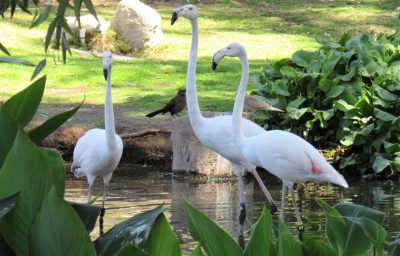
Welcome to Flamingo Cove, where the only thing more entertaining than the snowbirds fleeing the heat in droves is watching a group of teenagers come face to face with adolescence.
In terms of entertainment, it doesn’t get much better than watching seriously awkward birds navigate puberty. Just when you wrap your mind around the fact that thousands of years of evolution has resulted in what is essentially a floof of pink cotton with questionable reasoning skills balanced on stilts… in stumble the kids. Think it can’t get more ungainly than adult flamingos? Think again! Adolescent flamingos redefine awkward; they’re doing all the same things that the adults are doing, just mostly doing it clumsily.
And we’ve got 11 of ‘em.
Any animal born dependent on its parents to survive goes through some sort of learning curve. Some species need less time, and some need a bit longer. A rabbit is a familiar example of an animal that has a short childhood. Baby rabbits strike out on their own at about three weeks old; by then they have all the tools they need to survive. Some animals with more complex lives have longer childhoods. Orangutan moms take about seven years to teach their offspring everything they need to survive, and some human parents find themselves looking after dependent children for decades. (Hi mom and dad!) Birds have the full spectrum; some kiwi chicks are out on their own soon after hatching, and California condor chicks hang out with their folks for about two years.
Flamingo chicks rely on their parents for food for only the first 1-2 weeks, but the chicks may remain in the flock their whole lives, learning survival skills from the adults. Depending on the species, flamingo chicks mature between 3-6 years of age, but learning how to navigate the flamingo lifestyle can take significantly longer.
Our youngest chicks are three years old; teenagers in flamingo years. They still sport the greyish coloration of youth, but they’re already practicing the social skills they’ll need as adults. As with any learning curve, especially ones involving teenagers, there’s plenty of trial and error to watch. Some of the chicks have begun participating in the courtship dance, and the more confident birds are enthusiastically head flagging and saluting… at random intervals and mostly in the wrong order. As the older birds are marching together in unison, one of the kiddos will suddenly salute, diverting the others and halting the momentum. It’s like practicing a new dance move in a mirror at home, but in full public view of everyone.
There are even a couple of advanced youngins who have caught on to the whole “nest mounds” stage of the flamingo season. Having seen some of the adult birds collect nesting materials and guarding nest mounds, yearlings Goose and Mav (black bands 4 and 5) are taking a shot at it too. Despite the savvy of their namesakes, Goose and Mav spend long periods of time standing on the nest mounds and examining the ground closely as if waiting for something to happen. So, while the adults around them are precisely shaping and adding to their nests, Goose and Mav are staring at the ground. They’re not defending, shaping or building… just standing still with their heads dropped… staring at the mud.
It’s an entertaining time to stop by.
In other news, Alexis and Andy are still an item, and joining the courtship dances with gusto. Ross and Rachel, Theresa and Robert and Ted and Delilah are all still together and squabbling with any birds that intrude on their space bubbles. Herman is still out on his own, looking for love. Don’t despair, Herman… at least you’re not a teenager….
Episode 8: The Alexis and Andy Show
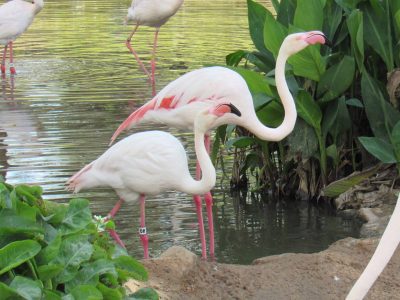
Welcome to Flamingo Cove, where the only thing hotter than the temperatures in October are the dance moves of the birds…
Well, it’s official. Herman is back to square one. Without the calm, steady influence of diminutive ex-girlfriend Theresa, he’s forgotten how to flamingo. Recall back from Episode 2 that Herman struggled to fit in at first; he didn’t seem to understand how the whole, “tall pink birds in a group” thing worked. (A group of flamingos is called a flamboyance! Isn’t that just wonderful? I’d like to meet the person that coined that term and thank them effusively for making my corner of the world just a tiny bit better.) Back to poor Herman: Theresa had taken him under her wing (see what I did there?) and revealed the secrets of life in the flamboyance, but he’s out on his own again. He had taken to following around one of the older females for a bit, but that seems to have fizzled out as well. So, Herman’s schedule has more aimless wandering built into it these days, but he does enthusiastically join in early if the others start the courtship dance. As one of the tallest birds, Herman’s head flagging game is an important addition for recruiting other dancers. Someday he’ll be adopted by another bird and can follow their example the way he used to do with Theresa.
In related news…Theresa has hooked up at last – with Robert! (For those of you following along at home, Robert was the satellite third wheel orbiting established couple Ross and Rachel. It seems that suddenly solo Theresa was tempting enough to lure him away from his efforts to insert himself between those two. Ross and Rachel appear to be solid as ever, occasionally pausing their synchronized napping to join in on a little head flagging. Ross and Rachel are among the least dramatic birds, which is probably why Robert was tolerated for so long.)
Finally, that brings us to our favorite drama queen. A quick recap of Alexis’s broken hearts trail….She started out by luring on-again-off-again Ted away from Delilah, and then immediately lost interest and refocused her sites on Herman. Herman wasn’t immediately taken in by her, but he wasn’t immune either. Alexis seemed to be playing Ted and Herman off each other, sometimes watching while the two of them squabbled. From there she moved on to Patrick, who was also being courted by Robert at the time. Patrick’s lack of attention drove Alexis back to old flame Ted, which left Patrick alone long enough to be courted by current beau David. Meanwhile Alexis walked away from all of them and picked up with Andy, and now, you’re all caught up!
Alexis is still with the volatile Andy, and these two are boiling hot. Always eager to jump in on the courtship dance, they’re not afraid to kick it off as well. You’ll rarely see these two napping; they’re either dancing, eating or reminding the neighbors to keep their distance. If they ever manage to raise a chick together it’s going to be one energetic ball of floof.
When will we be seeing chicks, you ask? That’s the big question. Unlocking the precise recipe needed to get these birds through the entire process of pairing up, building nests, laying eggs, and incubating them is like baking a souffle… sometimes you get it right and everyone gets dessert, and sometimes you’re sulking and serving store-bought cupcakes. Many of the variables are out of our control; sometimes all we can do is show up with a dessert fork and hope for the best.
Episode 7: Upside Down
Welcome to Flamingo Cove, where the only thing melting faster than an ice cube in summer is your idealist dreams of forever relationships….
Flamingos spend a lot of their time with their heads upside down already, so when the upended reality that is 2020 starts to make even their world seem chaotic, that’s some serious upheaval. True to form, 2020 smacked me upside the head with another reminder that nothing is real anymore when I spent few moments in the sticky humid morning air watching yet another brick from my reality wall get poked out and smashed to bits. OK, that’s a bit dramatic even for me, but still – I was surprised.
You may be asking, why DO they put their heads upside down in the water? (You may not be asking that but hop on board while we answer it.) Surely there must be an easier way to eat. The answer is yes, there are an infinite number of more practical ways to eat, but flamingos have never bothered with practical matters, and if you haven’t learned that by now you haven’t been paying attention.
The flamingo feeding system is, like everything else they do, ridiculously complex and silly. It’s also an ingenious way to exploit a resource unavailable to everyone else, which means less competition for food in an environment where food is survival. When algae and tiny invertebrates were passed over by other animals (save baleen whales) as too small to bother with, flamingos executed a metaphorical knuckle crack and got down to the business of harvesting this abundant food source.
By eating the microorganisms that live in soda lakes, flamingos not only reduce competition with other animals, they also cut down their commute time, because they nest on soda lakes as well. The lakes provide a caustic moat around the greater flamingo nesting colony that deters predators such as jackals and hyenas.
Nature: Food and shelter in one spot that deters other animals?
Greater Flamingos: Yes, please.
Nature: You’ll need to be upside down to eat this.
Greater Flamingos: We have ankles for knees; upside down is on brand.
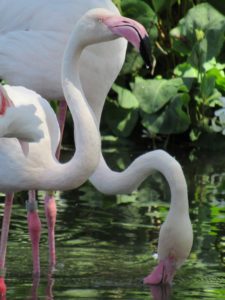 “Whatever. It’s working.”
“Whatever. It’s working.”
And so that’s how the upper bill of the flamingo developed into a strainer used to trap small aquatic organisms. The birds use their feet to stir up sediment and then lower their bills into the water, using their tongues to push water through the strainer, which is actually called a lamella, and trapping food inside. So, although standing in shallow water and dancing while dangling their heads upside down may look silly, it is a pretty effective survival strategy.
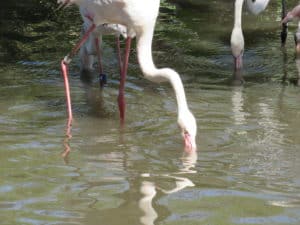
When they’re not eating, flamingos are of course navigating the perilous waters that are the rules of flock life. Sticking with the upside-down theme, adorable couple Theresa and Herman appear to have called it quits, as Herman was spotted pairing up with a female six years older than he is. Herman was the late bloomer and took several years to figure out how to flamingo. Maybe an older woman can be the role model he’s never had? Theresa so far has rebuffed any romantic overtures from other birds, content to hang out on her own. Theresa is a confident bird, and she will not have any trouble finding a partner when and if she’s ready.
The other development of note this week is that Robert appears to have been ejected from his orbit around Ross and Rachel. Not sure whose idea this was, but he’s clearly abandoned any attempt to join that couple. For now… If you’re cruising past the flamingos, slow down to check out the greater flamingos – you may be the first to know of any developments!
Episode 6: Alexis Strikes again...
Welcome to Flamingo Cove, where the only thing higher than the air conditioning bill is the pile of broken hearts behind Alexis.
Last episode, we rejoiced in the predictability of long-time couple Ross and Rachel. I hope you got your fill, because Alexis is up to her old tricks, and things are changing fast! Well, as fast as things change when you’re standing on one leg, I guess.
So, why DO they stand on one leg? The short answer is that no one really knows. Standing on one leg likely has several benefits for the bird and picking out the most important or most beneficial reason is like choosing your favorite color; it kind of depends on context. One theory is that it helps retain body heat. Flamingos lose the most body heat through the exposed skin on their long legs, so pulling one of the legs up into their body feathers helps them stay warm longer. This is handy if you live in areas where it gets cold or you happen to find yourself standing in cold water regularly.
Another interesting theory is that sleeping in this position allows the bird to maintain vigilance while resting. Other animals, including dolphins and ducks, are known to rest half of their brain at a time, and during that time the “awake” side is dominant. Perhaps, flamingos keep the side of the brain controlling one leg awake, which allows them to rest the half of the brain.
Maybe it’s a more efficient use of energy to stand on one leg. Current research shows that flamingos sway less on one leg than when balanced on two, which suggests that they may use less energy to stay upright when using a single leg. We know that the joints and structure of a flamingo leg allow the birds to lock in that position, although we aren’t yet clear on exactly how that mechanism works. So perhaps the one-legged stance is the “neutral” stance, and that using both legs together requires more effort?
Maybe the birds understand that one-legged yard ornaments are easier to install, and they wish to reflect that in nature. I don’t know – I’m just throwing out ideas here. The bottom line is that we don’t know for sure and that it’s probably beneficial to the bird in more than one way. (Although I will concede that the lawn ornament thing is a stretch, even by crazy flamingo standards.) It certainly makes them fun to marvel at when they’re sleeping. When they’re awake, flamingos don’t need to make themselves fun to watch; the constant upheaval between individuals will keep you plenty busy. Especially since our old friend Alexis is leaving a trail of broken pink hearts in her wake…
When we last checked in with Alexis, she was hitting on Ted in response to another male, Robert, demanding time with her then current companion Patrick. (With me so far?) Well, it seems like that may have spelled the end for Alexis and Patrick, because Alexis is spending most of her time these days with Andy. Andy can be identified by his yellow-band with the number 19 on it. He’s been on the periphery of the action since early spring; mostly watching, occasionally drawn into whatever Alexis is up to. It seems Andy is another in the long-list of potential mates Alexis keeps in her orbit, and for the moment he’s basking in the glow of favoritism. Andy is one of the birds who has the most trouble with flock life; he likes plenty of space around him and has a hair trigger reaction to any perceived invasion of that space. These two both seem to enjoy a spot of drama, so perhaps they’re made for each other.
So if Alexis dumped Patrick, what is Patrick up to? I’m so glad you asked… The later it gets the more urgent it becomes for the birds to sort out who they’re going to do this whole parenting thing with. It seems Patrick is taking the opportunity to reevaluate some of his relationships. Patrick has often been seen in low-level conflict with another male, David. David has a yellow-band with number 22 on it. (In case you’re keeping track.) David has a bit of a playboy personality; taking opportunities to spend time with lots of other birds. David and Patrick had a generally antagonistic relationship, sort of a simmering dislike. They would toss a half-hearted swipe at each other when they passed, but it didn’t seem to escalate beyond that. Well, maybe the abrupt departure of Alexis was all Patrick needed to turn that spark into a flame. It’s not unusual for greater flamingos to form same-sex couples; two males will defend a nest site even though there’s no egg or chick to raise. It’s not clear if these two are committed enough to stick together for a nesting season, and based on the space they allow to develop between them I’m guessing it’s more of a diversion than a long term gig. It will be interesting to see what happens with these two as courtship kicks into high gear, as both David and Patrick are enthusiastic practitioners of the wing salute. Will Patrick and David stay together? Will Andy be just another broken heart in Alexis’s wake? Only way to find out is to wait and see…

One-legged Stance

David and Patrick
Episode 5: Ross and Rachel
Welcome to Flamingo Cove, where the only thing more predictable than the summer heatwave is finding flamingos Ross and Rachel together.
There’s something to be said for steadiness and predictability, especially now when things feel so chaotic. With all the uncertainty happening around us, I thought it might be a good time to introduce Ross and Rachel, who are generally a spot of calm in the sea of unrest that is the flock. Both have white bands on their legs; Ross sports the number 13, and Rachel’s band has the number 14 on it. These two are almost always found together, and while they don’t often lead the courtship ritual, they are among the first to join in. Mostly they’re content to rest or feed next to one another, exhibiting the quiet confidence of a rock-solid relationship. 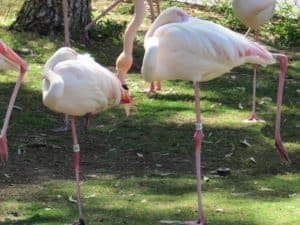
A reminder that flamingos live a long time; the world’s oldest known flamingo died at age 83, so Ross and Rachel would have decades of quiet happiness to look forward to… if only they weren’t flamingos. You see, even though these two appear chill their neighbors are either throwing a dance party or a UFC match and sometimes both at the same time.
As mentioned in the previous episode, Ted sometimes uses Ross as a verbal punching bag so he can play the hero for Delilah. So, Ross sometimes finds himself in the middle of a fight he didn’t know he was in. He is a tall bird and can hold his own, and even though Rachel seems to prefer staying out of it, she has been known to jump in if it looks like her team might be losing. Rachel saves her assertiveness for claiming nest sites. One day last week she lay in wait for one of the other females to leave her mud nest mound for a bite to eat, and then Rachel quietly moved in and sort of just refused to leave. The original owner returned to find Rachel firmly planted in her spot as if she’d been there the whole time.
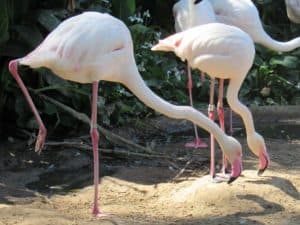
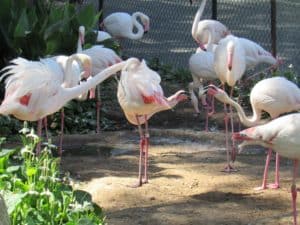
Keep in mind that no actual nests have been built, and the conditions for colony breeding haven’t been right yet so this “nest” Rachel moved into is more the suggestion of a nest than an actual nest. It would require extensive renovations to qualify as a place to lay eggs, but at the time it was the only thing going so she took it. Since then the spot has been abandoned by both…. I don’t know; these birds are weird, man.
When they’re not fending off undeserving aggression or claiming a nondescript mound of mud, these two are calmly feeding or preening together. If you were watching the flock, you might skip right over them, assuming there was nothing of note happening with this couple. But of course, you’d be wrong about that.
If you observed these two love birds for any length of time, you would eventually notice the constant hovering presence of a third bird. A male flamingo named Robert with the number 12 on his white band is almost always nearby; he rests near them, feeds near them and preens near them. 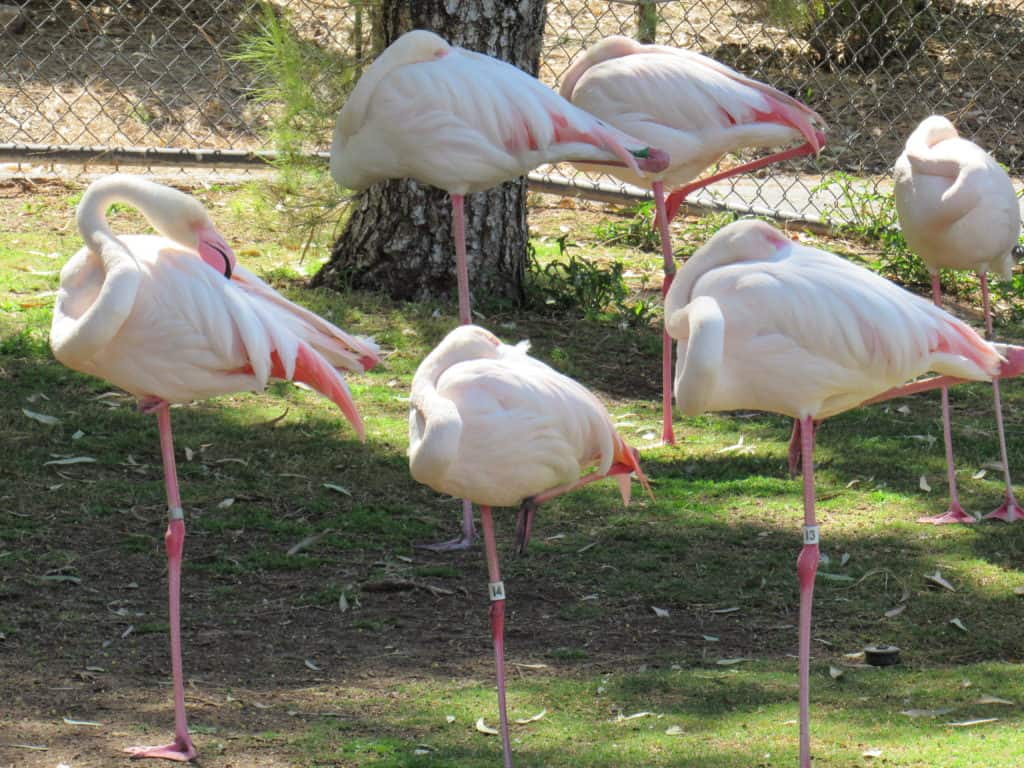 Only once has he jumped in between them in a bid to take over as half of the couple, but it wasn’t clear if he was trying to replace Ross or Rachel – or even if it particularly mattered. The brief takeover bid was unsuccessful, and our would-be usurper spent some time with another male before eventually returning to his orbit around Ross and Rachel. Oh, and that “other male?” His name is Patrick, and he has been hanging out with Alexis the troublemaker for a few weeks now. When the usurper showed up it sent Alexis into a jealous rampage in which she made another pass at Ted, who in turn picked a fight with Ross, who was standing next to the usurper again by then. (Isn’t this fun?)
Only once has he jumped in between them in a bid to take over as half of the couple, but it wasn’t clear if he was trying to replace Ross or Rachel – or even if it particularly mattered. The brief takeover bid was unsuccessful, and our would-be usurper spent some time with another male before eventually returning to his orbit around Ross and Rachel. Oh, and that “other male?” His name is Patrick, and he has been hanging out with Alexis the troublemaker for a few weeks now. When the usurper showed up it sent Alexis into a jealous rampage in which she made another pass at Ted, who in turn picked a fight with Ross, who was standing next to the usurper again by then. (Isn’t this fun?)
Through it all, the bond between Ross and Rachel remains consistent. Is it possible that Robert will be integrated and participate in raising chicks with them? Yup. He might also displace Patrick and pin Alexis down to a long-term commitment. Or, he might defend a mud patch by himself all summer. Who knows? None of us can know what the future holds. The best we can do is hang on to what is important, take a breath and plunge forward. Rest up everyone, there’s a long summer ahead, and plenty of drama still to be had in Flamingo Cove; and believe me, you don’t want to miss any of it.
Episode 4: Toddler Dance Recitals, but in pink
Welcome back to Flamingo Cove, where the only thing rising faster than the temperature is the tension in the flock…
Phoenix in summer is hot, and not in a good way. There is one thing to look forward to however: the increase in courtship behaviors in the greater flamingo flock. Summer is when the birds start practicing their moves and mate selection moves into the playoffs.
Successful flamingo breeding depends on a long list of conditions including weather, consistency of the mud needed to build nests, and a bunch of other stuff we’re still figuring out. Identifying breeding requirements will allow us to better protect wild flocks and their habitat, so this is important stuff. We’re watching closely and trying to provide the things we can, such as materials and space, but some things like weather are out of our control. And flamingos are extra high maintenance because their courtship rituals are ridiculously complex; they must be performed exactly right or else nobody gets baby flamingos. Because of course they are.
Our greater flamingo flock is made up of mostly young birds brought together from three other zoos, and they are now old enough to begin thinking about a family. Since they didn’t grow up around adult birds who could show them how it’s done, our birds are relying on instinct to nail down the specifics of the flamingo dating scene, and…well let’s just say it can get pretty messy.
Courtship behaviors occur in a hierarchy, building on each other as excitement rises within the flock. The purpose is to make sure the whole flock is on the same page, ready to build nests and lay eggs together, so they can protect each other from predators by the force of numbers. Each step requires group cooperation and practice. Step One is called Head Flagging. Based on the, “alert, something’s wrong,” posture, interested birds stand very tall, and swing their heads from side to side in deliberate motions as if they’re watching a fast-paced tennis match.
Step One: Head Flagging
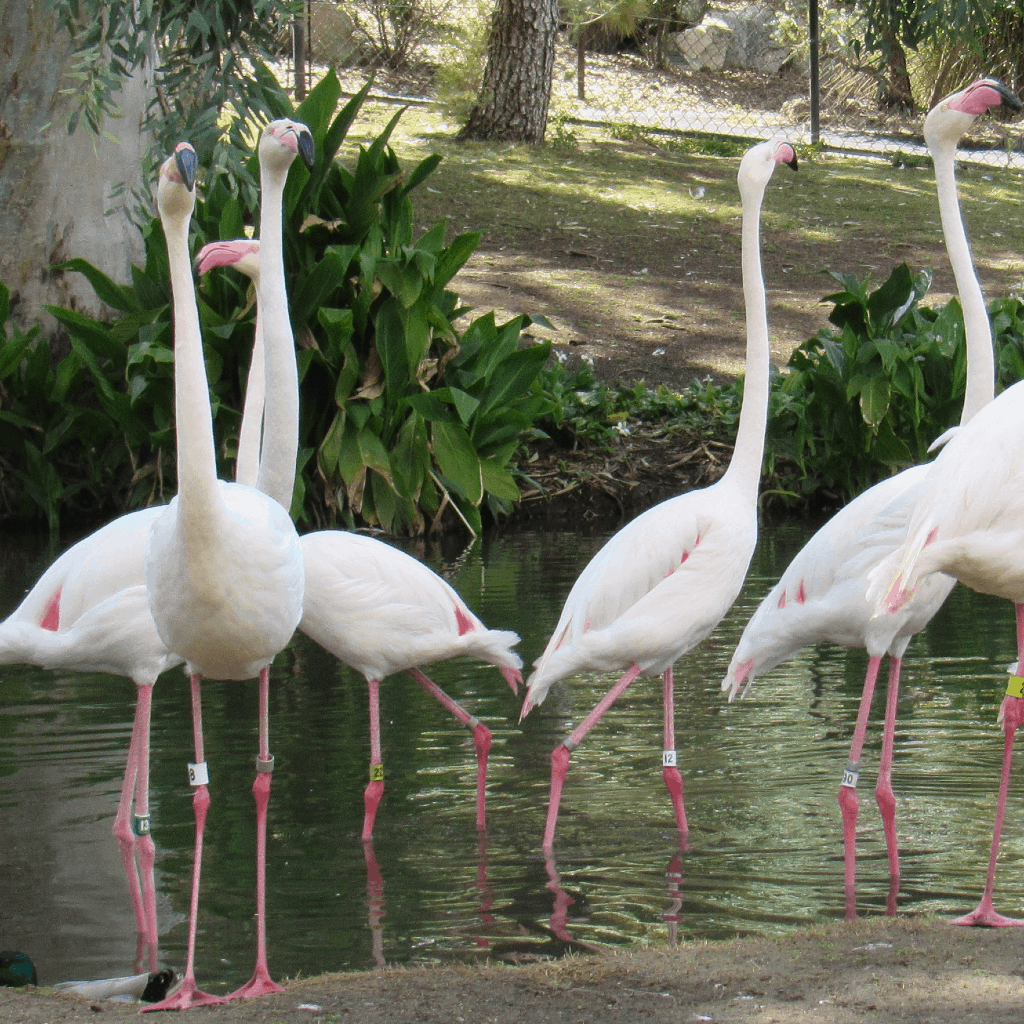
As other birds join in, things may progress to Step Two: Wing Salutes. While continuing to stand very tall, birds will extend one or both of their wings. If there are enough birds doing wind salutes, things can get quite fancy. Variations of wing salutes start showing up that involve fake preening, bowing, and may include low growling sounds.
Step Two: Wing Salutes (hubba hubba)
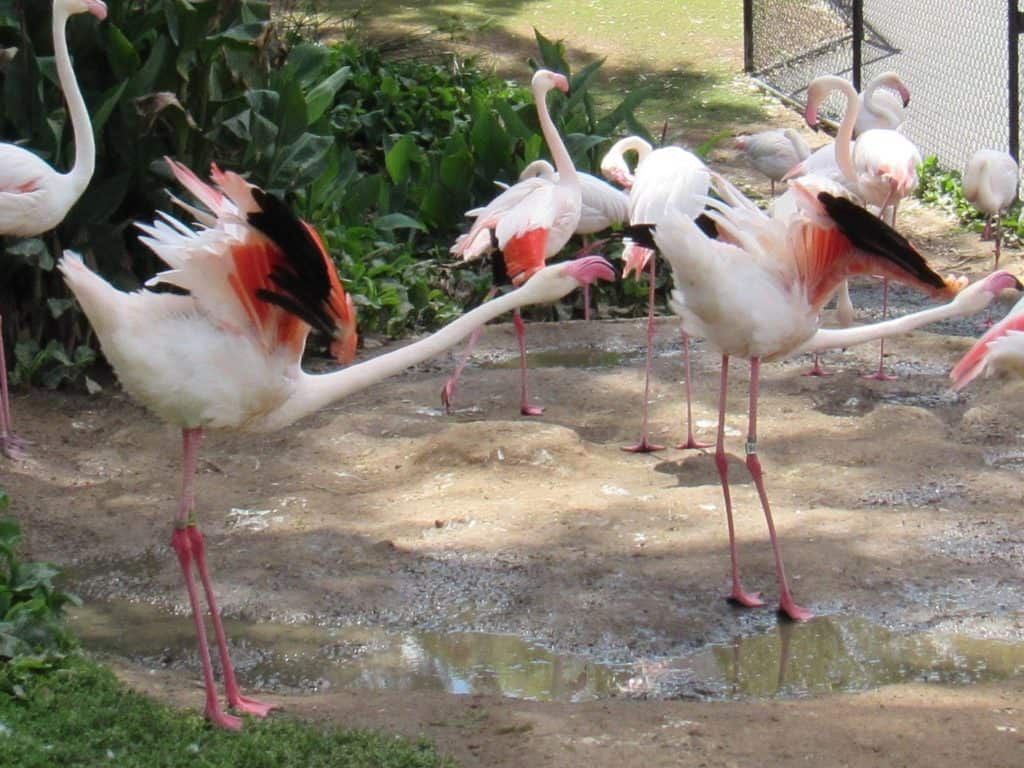
When the majority of a flock is doing wing salutes, (regular or fancy,) one of the birds will ask if everyone wants to Step 3: March. This is it: this is the end game. This is the most exciting, and dramatic display you’ll see in a flamingo flock. It’s what you watch while David Attenborough explains the scarcity of pristine soda lake habitat in every BBC documentary. (Is it me, or are they starting to repackage some of that stuff? I think I’ve seen the same footage of sharks in two different versions of Blue Planet; Blue Planet Original Flavor and Blue Planet 2: Electric Boogaloo. But I digress…) Step 3: The March… starts with a peculiar fluting call, which sounds like a cat mewing. (It also sounds a lot like the voice of the balance board in Wii Fit, if, like me, you’re resurrecting your well-intentioned but long-abandoned fitness plan and are hearing that voice again asking if you want to hear a fitness tip. Newsflash: We don’t.) The mewing call happens no other time, and as it’s picked up by the whole flock, the march ensues. Birds form a close-packed, high-stepping, head flagging flock that moves in unison like a school of fish. Executing sharp turns and precision moves, a flock can march like an army on parade for minutes at a time.
The process only progresses if all the other steps happen in the right order and with enough synchronized participation of individuals. If one or two birds show up late and start head flagging when everyone else is already saluting, it can throw off the timing and the whole ritual breaks down into chaos. Young flamingos need a lot of practice even if conditions are ideal, so our flock has more trial and error ahead as they’re figuring out their timing.
The good news? Practice happens all the time and it’s fun to see. Watching our flock practice is like watching a toddler dance recital – the will and ability are there, but the pulling-it-all-together-on-stage part is still a bit chaotic. The birds rev each other up, executing precision head flagging. Excitement builds as they perform increasingly fancy wing salutes! The fluting call goes out! Others take up the call as they pull in closer ready to march! This is it! Finally! They begin marching! …In all different directions. Over and over they try; head flagging is flawless, the salutes are fancy by any standard, but the marches…? Well, let’s just say when the curtain goes up, its more frozen stares and waving at parents than choreography. And of course, there is always the one in the back row dazzled into a stupor at the light reflecting off shiny shoes… They’ll get there. Someday. Meanwhile, it’s great to watch them practice and celebrate their little successes.
Some of you may have had a chance to see the flock as you drive past during Cruise the Zoo. Although sometimes it may appear as though the birds are asleep in the pool, rest assured the drama hasn’t slowed. Alexis our socialite troublemaker is once again at the center of the action, keeping her on-again-off-again boyfriend Ted on the hook while at the same time casting about for other opportunities.
Poor Ted. You know Ted. Ted is the boy next door; the heart of gold wrapped up in an easy going and affable, if somewhat clueless disposition. If Ted were a human, Ted would be a really good football player… 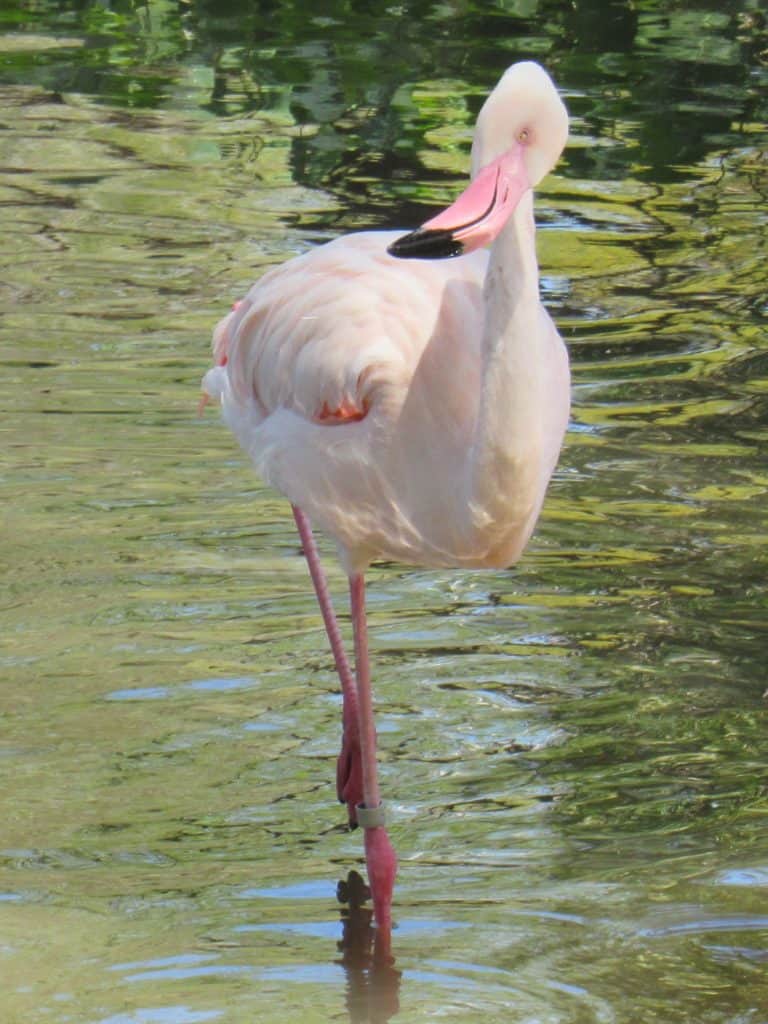
Ted is most easily identified by his leg band, which is yellow with #24 on it. His behavior is less predictable because he’s more subject to the whims of others than some of the other birds we’ve met, which means sometimes he finds himself knee deep in the proverbial muck with no idea how he got there….
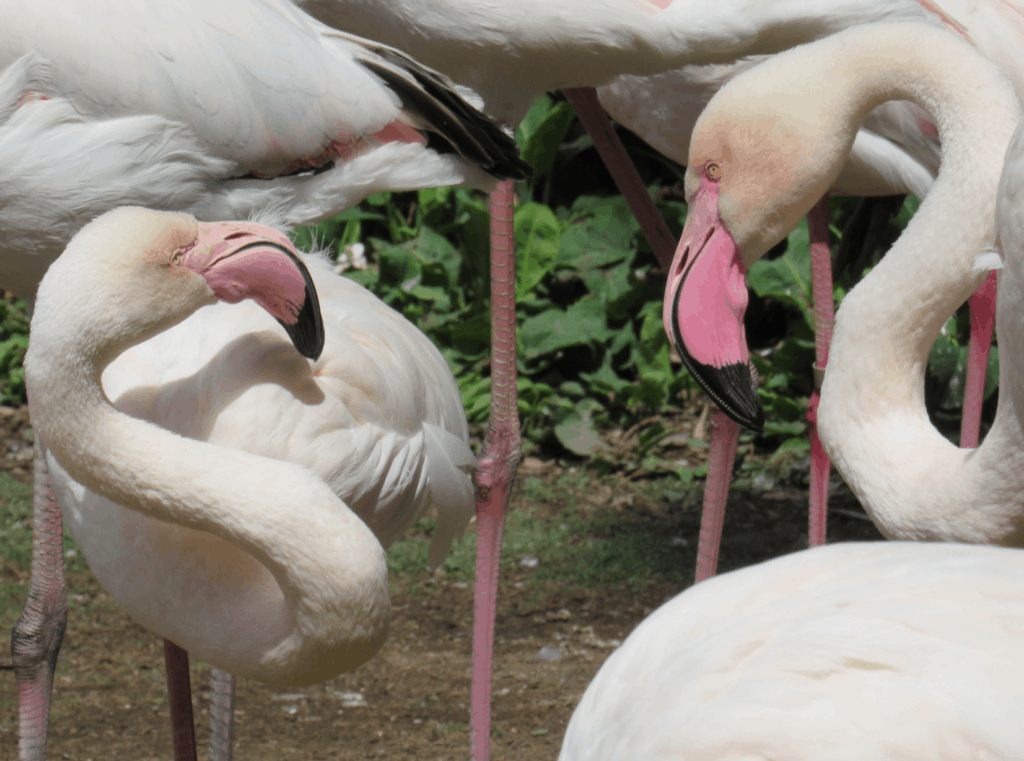 Ted has a nice girl. Her name is Delilah. Her yellow leg band has a number 20 on it. Delilah is smart; she stands her ground and knows her own worth. She’s a great dancer; generally among the first to catch on to the status of choreography practice. She and Ted are still a new couple, but things are going well…unless Alexis is on the scene. Delilah doesn’t bother with Alexis, and she doesn’t bother with Ted when Ted is bothering with Alexis. For some reason when Alexis comes calling, Ted plays the smitten fool every time. When she’s had her fun, she moves on and Ted is left all alone, wondering what happened.Inevitably he has to catch up on the dance moves that Delilah has perfected in his absence. His bumbling, self-deprecating demeanor gets him back into good graces with Delilah.
Ted has a nice girl. Her name is Delilah. Her yellow leg band has a number 20 on it. Delilah is smart; she stands her ground and knows her own worth. She’s a great dancer; generally among the first to catch on to the status of choreography practice. She and Ted are still a new couple, but things are going well…unless Alexis is on the scene. Delilah doesn’t bother with Alexis, and she doesn’t bother with Ted when Ted is bothering with Alexis. For some reason when Alexis comes calling, Ted plays the smitten fool every time. When she’s had her fun, she moves on and Ted is left all alone, wondering what happened.Inevitably he has to catch up on the dance moves that Delilah has perfected in his absence. His bumbling, self-deprecating demeanor gets him back into good graces with Delilah.
Ted also sometimes invents rivalries with other males so that he can “defend” Delilah from their intentions. One of the frequent targets of this ploy is Ross, who sports a white band with number 13. Ross is in a solid, long-time relationship with Rachel, (white band number 14) and is no threat whatsoever to Ted and Delilah. Even so, Ross finds himself facing a display of aggression from Ted, just so that he can play hero for Delilah. Delilah seems to be wise to his games, and sometimes adopts an air of quiet exasperation during his stunts. (The look is hard to explain, but instantly recognizable.)
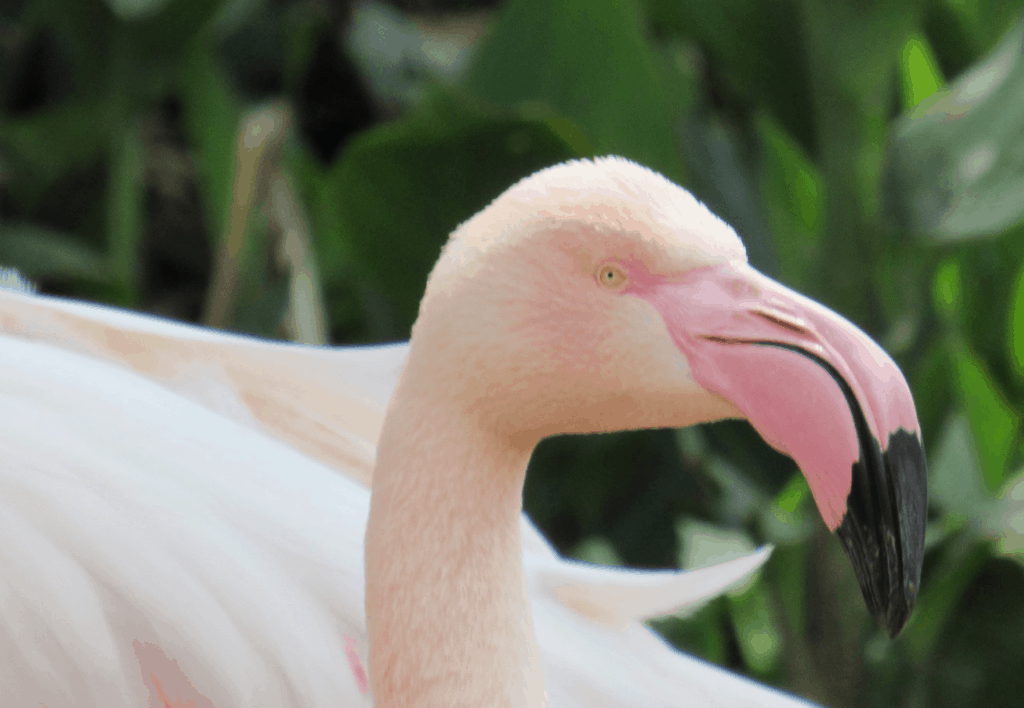
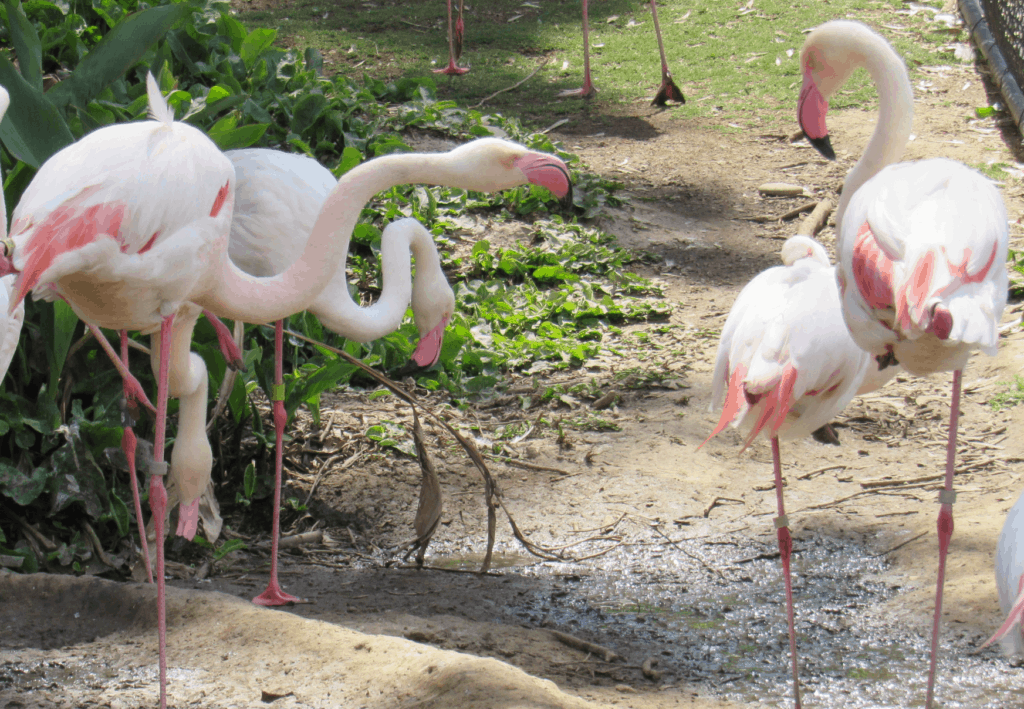
Last week when Alexis was flirting with Ted to make Herman jealous, Delilah continued to perfect increasingly fancy flourishes on her wing salutes, and she can now command the attention of any bird in the flock. Ted has a lot of practice to do if he hopes to match her skill level. Lately Ted has been sticking extra close to Delilah, and Alexis is nowhere to be found. Will Ted focus long enough to cement his bond with Delilah going into mating season? We’ll have to wait and see….
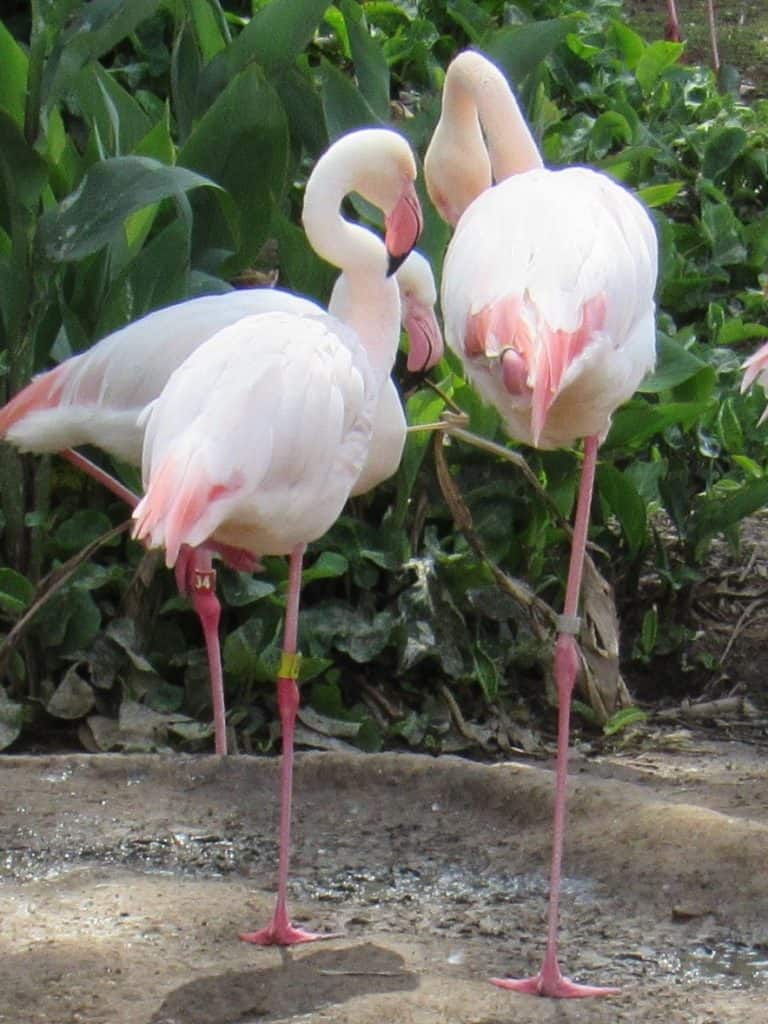
Next week… we’ll meet Ross and Rachel…
Episode 3: You Do You, Boo
Welcome back to Flamingo Cove, where the only thing more dramatic than the desert sunsets are the love lives of the birds.
Last week we met diminutive Theresa and her lovable, rule-following mate, Herman. Today we will check in with our drama queen Alexis and meet Dexter, who didn’t let his physical disability stand in the way of wooing an incredible girl with a heart of gold. Now the only question is… can he hang on to her?
But first… let us talk about the color pink. You will remember from Week 1 that there are six species of flamingos and that they all have their own color variations. Chilean flamingos like the ones we have on the tropics trail are a particularly flamboyant shade of pink, while the greater flamingos we’re talking about are a muted pale pink. Flamingos get their color from the carotenoids in their diet, which includes various species of crustaceans, brine shrimp and blue green algae, (which is now more correctly called cyanobacteria, but don’t even get me started on that!) You know how when we cook shrimp, they turn pink? It’s because cooking the shrimp unravels the protein that covers the carotenoid and reveals the color, and the digestive process of the flamingo basically does the same thing. Each flamingo species feeds on the carotenoid-filled menu options around them, which have different amounts of pigment and are then used by the birds in all sorts of places.
Vocabulary Alert: Uropygial gland. (Yer-OH-pidge-ee–ull) gland.
It’s fun, huh? I like it, too.
This is sometimes referred to as the preening gland by non-nerds, and birds use the secretions to keep their feathers in good working condition, but the flamingos also use it to make risky fashion choices. They paint themselves in different ways; the Chileans use it all over, but the greaters really focus on their wings. The more vivid the color compared to others in the flock, the healthier and more attractive the bird is to others. (This concept is not universal. Humans do not find other humans with bright pink wings universally attractive. Learned that one the hard way.) I do enjoy the thought that maybe flamingos paint themselves with intention and self–awareness; in my head, Dexter is the Picasso of the flock.
Who’s Dexter? Oh, I’m so glad you asked…
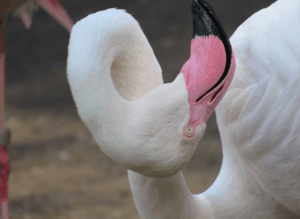 Dexter is our wildcard, our “you do you” bird. He has an anomaly with his neck which may be the result of an injury he got as a chick, but we aren’t sure. It affects him when he is focused on preening and settling down to rest, and it causes his neck to temporarily lock in a corkscrew formation. It only lasts a minute or so and it does not seem to cause him any pain, so while we monitor it closely for changes, he’s not being actively treated for it. He’s easy to monitor because he is the self-appointed disciplinarian regarding the punctuality of his meal delivery service. Should the keeper on duty arrive with breakfast even a minute late, Dexter will march right up to them and stare straight into their eyes as if in reprimand. I’m told it’s a disquieting experience and enough to make one wonder what is happening behind that steely, if vacant, glare. If his neck isn’t corkscrewed and he’s not scolding his caterer, you can identify him by his leg band, which is yellow and has the number 21.
Dexter is our wildcard, our “you do you” bird. He has an anomaly with his neck which may be the result of an injury he got as a chick, but we aren’t sure. It affects him when he is focused on preening and settling down to rest, and it causes his neck to temporarily lock in a corkscrew formation. It only lasts a minute or so and it does not seem to cause him any pain, so while we monitor it closely for changes, he’s not being actively treated for it. He’s easy to monitor because he is the self-appointed disciplinarian regarding the punctuality of his meal delivery service. Should the keeper on duty arrive with breakfast even a minute late, Dexter will march right up to them and stare straight into their eyes as if in reprimand. I’m told it’s a disquieting experience and enough to make one wonder what is happening behind that steely, if vacant, glare. If his neck isn’t corkscrewed and he’s not scolding his caterer, you can identify him by his leg band, which is yellow and has the number 21.
Dexter is a lucky flamingo, too, because he has managed to woo the gentle Glinda. Glinda (yes, named after the witch) has a blue band with the number 56 on it. She is a sweet soul; patient and willing to go with the flow most of the time. She stands firm but isn’t one to instigate aggression if another bird comes too close; content to let Dexter handle things, as you can see, Glinda stands quietly while Dexter handles a disagreement in his own very special way.
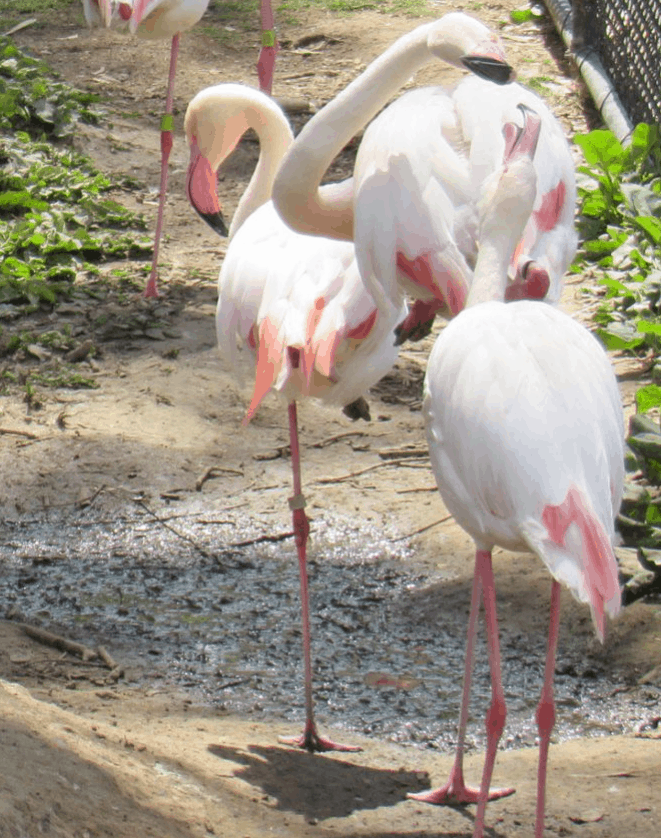
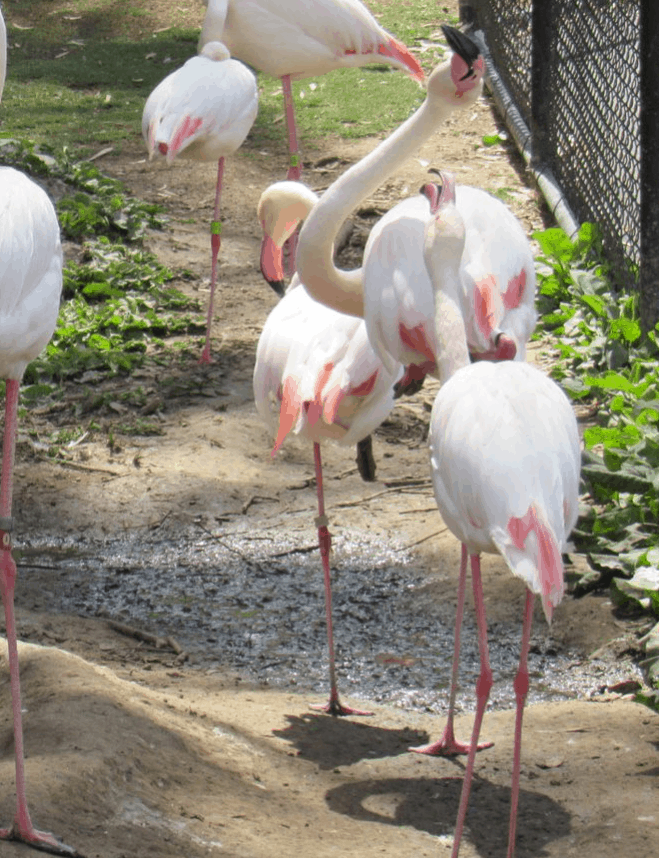
Glinda saw past Dexter’s corkscrewed neck to the good-natured bird he is on the inside, (once he’s had breakfast, of course.) This is a new relationship, so the two aren’t always in 100% sync just yet but they’re working on it.
It’s possible that when Dexter is hungry, he’s not super focused on details, because in this photo he is blindly following a female with a blue band, but its lovely female blue 13, not Glinda #56. 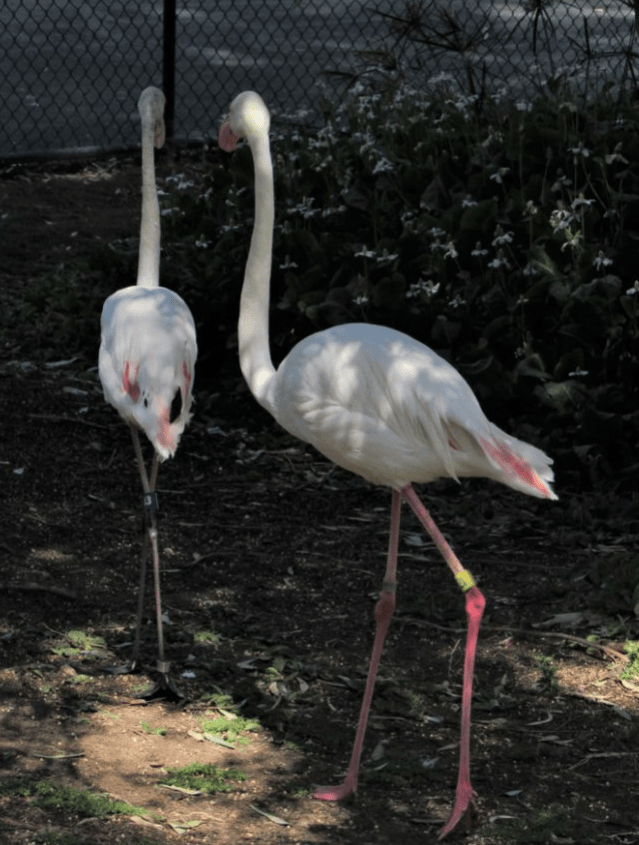
Maybe he was hangry…? Anyway, as soon as he realized what happened he hastened back to Glinda.
A quick update on Alexis… she is really getting into the courtship game. She seems to have gone back to her old on-again-off-again boyfriend Ted. (More on Ted next week.) Lately she’s been flirting heavy with Ted; flagging her head and parading around him and she really turns it up if Herman is around to see. Seems like Alexis isn’t happy about being rebuffed by Herman and is punishing him by lavishing her attentions on Ted.
Don’t worry too much about Alexis, though, because she’s always got back up plans. The last couple of days she’s been edging closer to another established couple.
She’s been known to join a pair of birds before…
Episode 2: Oh No You Didn't!
Welcome back to Flamingo Cove, where the only thing hotter than the summer sun is the heat from a flamingo trying to steal someone else’s mate…
A friend of mine who introduced me to the world of the flamingo drama described them perfectly: “obligate colonials with personal space issues.” For birds that have to live together, they really don’t seem to like each other very much. The exception is when birds pair up. When paired, they will stay very close together, sleeping, feeding and preening. They will be so close they’re often touching, and will aggressively defend their little space from any other bird that comes close. In general, the closer birds stand, the tighter the bond. If they manage to find someone they like, it is very important to remain close to that bird. (I’m just telling you the rules; I don’t pretend to understand them.)
Last episode we met Alexis the troublemaker. This time we’ll start with one of my favorite couples; Theresa and Herman. Theresa is named after Mother Theresa because of her sweet nature and impossibly tiny stature and NOT AT ALL after my sister, who also happens also to be incredibly sweet and teeny. You can pick out Theresa because she has a white band on her leg with the number 08 on it, or if you just scan the flock for the short one. She’s a lovely shade of pink and has an independent streak, so she’s not afraid to walk away from drama. Not that she can’t stand her ground to defend herself or her faithful mate, whose name is Herman after the character on the TV show, “The Munster’s.” You can pick Herman out by his white band with the number 95 written in green on it. The two of them are one of the strongest pairs and are usually standing close together. They have a sweet backstory, too…
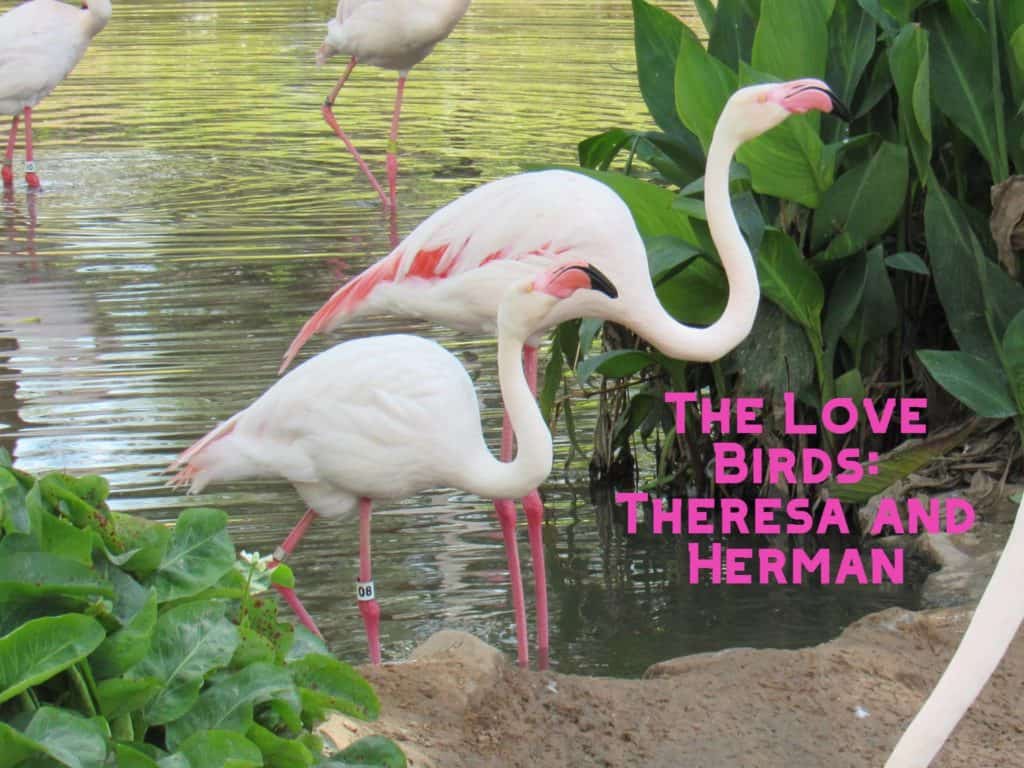
Herman seemed confused about being a flamingo at first. He would walk away from the flock and call out, as if searching for something he wasn’t finding. The other birds would call out to him, but he didn’t seem to want to join them. Eventually he came around and managed to pair up with Theresa. She had a bit more experience than him, and she’s more independent. During the beginning of nesting season a few years back, the birds begin building mud volcano nests and guarding them from other birds, who will sometimes steal materials for their own nests. Herman and Theresa had just started a small pile of leaves and twigs to begin their nest, and Herman was guarding it while Theresa slept next to him. One of the neighbors stole from another and it started a fight, which woke Theresa up. She stretched, walked a few steps away and went back to sleep. (Because she’s cool like that.)
Herman was completely flummoxed.
He needed to stand next to Theresa according to the rules, but he also needed to guard the nest! You could see his frantic thinking as he looked from her to the nest, to the thieving neighbors and back again. Then he did something surprising; he used his beak as a scrape, and carefully scooted the materials with him as he backed over to where she was so he could stand next to her. Sweet, huh? I know.
The thing is, flamingo behavior is complex. In the wild, they don’t breed every year; they wait for the conditions to be exactly right. What are those conditions? We don’t know! Closely observing our flock adds to the understanding of what they need in order to survive, find mates and raise a new generation. Once we understand, we can better protect wild flocks and the things they need to ensure their long term survival. And I do mean long term. The worlds oldest known flamingo died at age 83. You read that right; EIGHTY THREE. We have a lot to learn to ensure our grandkids get to see flamingos in the wild… scooting piles of leaves around because their mate fell asleep a few feet away.
Poor Herman.
Episode 1: single and ready to flamingle
There are six species of flamingos in the world and we have two at the Phoenix Zoo – Chileans and greater. All have long limbs and bear the hallmark pink color to varying degrees. To the casual observer they may look the same, but they vary widely in size and color patterns. Chilean flamingos are the darker pink of the two. They are native to South America and have ranges close to or overlapping with the Andean, Puna and Caribbean species. The greater flamingo flock resides at lakeside between the zebra and the otters. Greater flamingos are native to Africa, the Middle East and parts of Asia. They share some of their range with the other African species, the lesser flamingos. Habitat loss and disturbance impact all six species, but the greater flamingo populations are actually holding steady for the moment. Maybe it’s because no one wants to stir up that holy mess…
Flamingos in the wild live in large flocks for to maximize their safety, but if you watch for more than a minute, you kind of get the feeling they’d rather live alone. It’s a constant shuffle of proximity squabbles and mate stealing. The greater flamingos at the Phoenix Zoo have a little something for everyone: a glamorous diva, a dashing leading man, same-sex couples, underdogs, mentors, backstabbing friends, gentle souls, an endearing clueless one, hard workers, dirty double crossers, laid back friends, a particularly strict timekeeper, and a whole group of teenagers that do everything like they’re arriving at a Beyoncé show.
Over the next few weeks I’m going to give you an insider’s glimpse at the happenings in Flamingo Cove. Grab a bucket of popcorn, because while some of the birds are looking for long-term relationships, there are spoilers in the mix with chaos on their minds. I’ll cover some of the flamingo natural history as we go, but let’s dive in with an introduction to one of the most interesting birds to watch: Alexis.
Alexis is your typical socialite; she has lots of friends and is constantly moving between social circles, keeping her options open. Alexis is our troublemaker – she loves to stir things up. If only all troublemakers wore a yellow band with the number 23 written on it.. She’s not particular about her targets; she invites other flamingos of all sizes, sexes and personalities to get into trouble. She’s even been known to join established pairs and act as though there were three of them in the relationship the whole time.
Alexis isn’t interested in settling down. She can usually be found preening while the others are courting – but she isn’t ever far from the action. You never know what Alexis is going to do, but it’s sure to be interesting! Last year, Alexis began hanging around Ted (Yellow 24) and his girl until she finally convinced Ted to run away with her. Typical Alexis, it didn’t last long and as soon as she had him, she lost interest. Alexis has been hanging out with a new man this week, while casting flirty glances towards Herman, (Green 95) who doesn’t seem entirely immune.
If she succeeds in stealing him, it will create chaos throughout the flock. If only there were a way to warn him…
